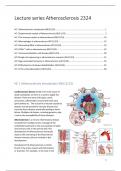Summary
Summary lecture series Atherosclerosis 2324
- Course
- Institution
Summary of all 11 lectures of the lecture Atherosclerosis. This course is part of the Master Bio-Pharmaceutical Sciences and is given in the first semester of the year 2023/2024.
[Show more]



